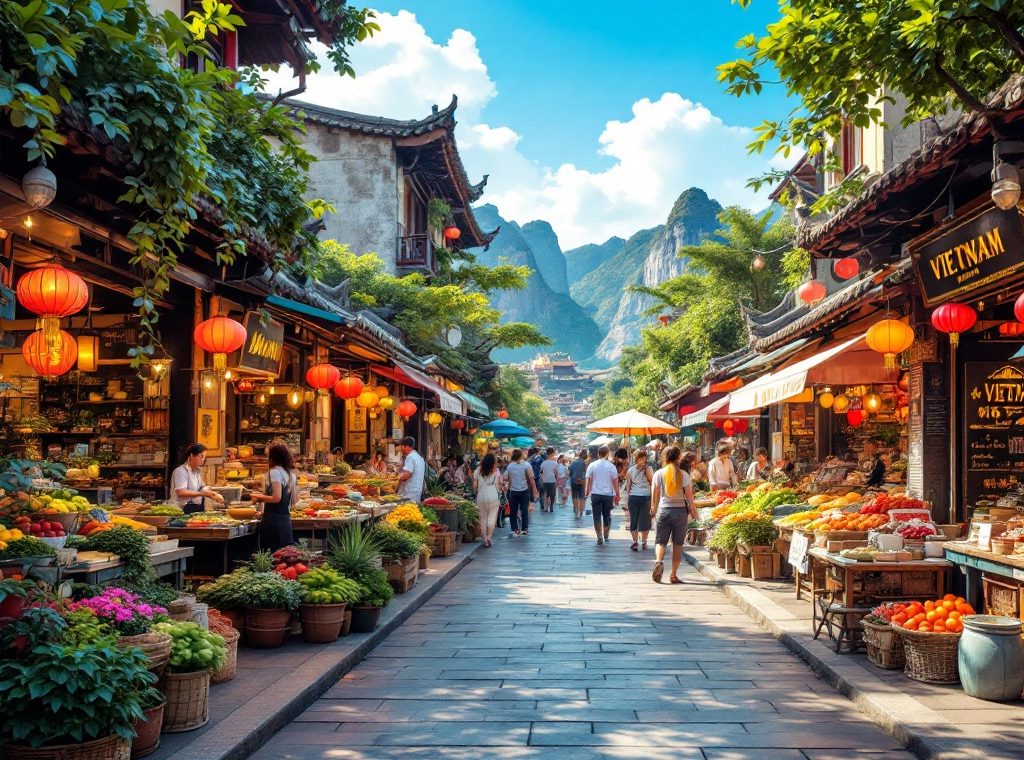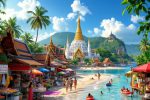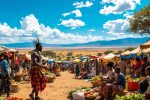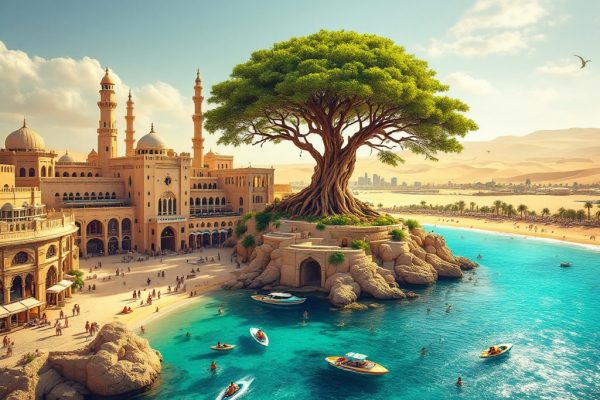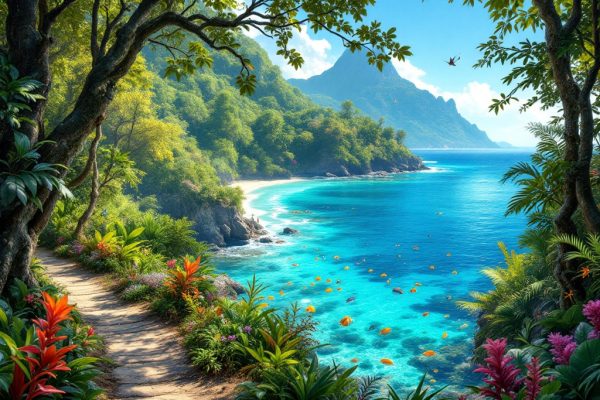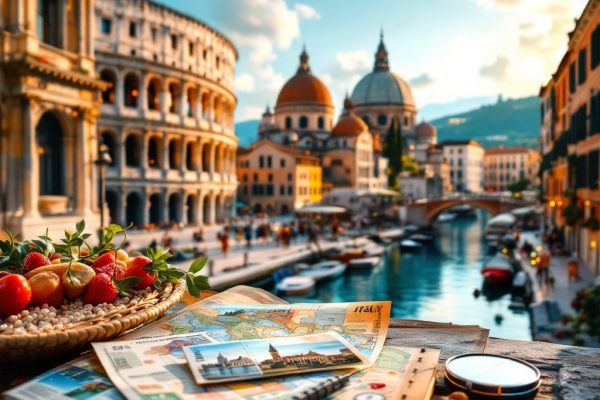A Comprehensive Approach: How to Make a Travel Guide to Vietnam
Dreaming of exploring Southeast Asia? Discover Vietnam, a land of captivating beauty and rich culture, from bustling Hanoi to tranquil Ha Long Bay. Explore ancient temples, savor delicious street food like pho and banh mi, and trek through stunning rice terraces. Plan your adventure with our comprehensive guide, covering visas, budgeting, transportation, and must-see destinations. Start your Vietnamese journey today!
Important information
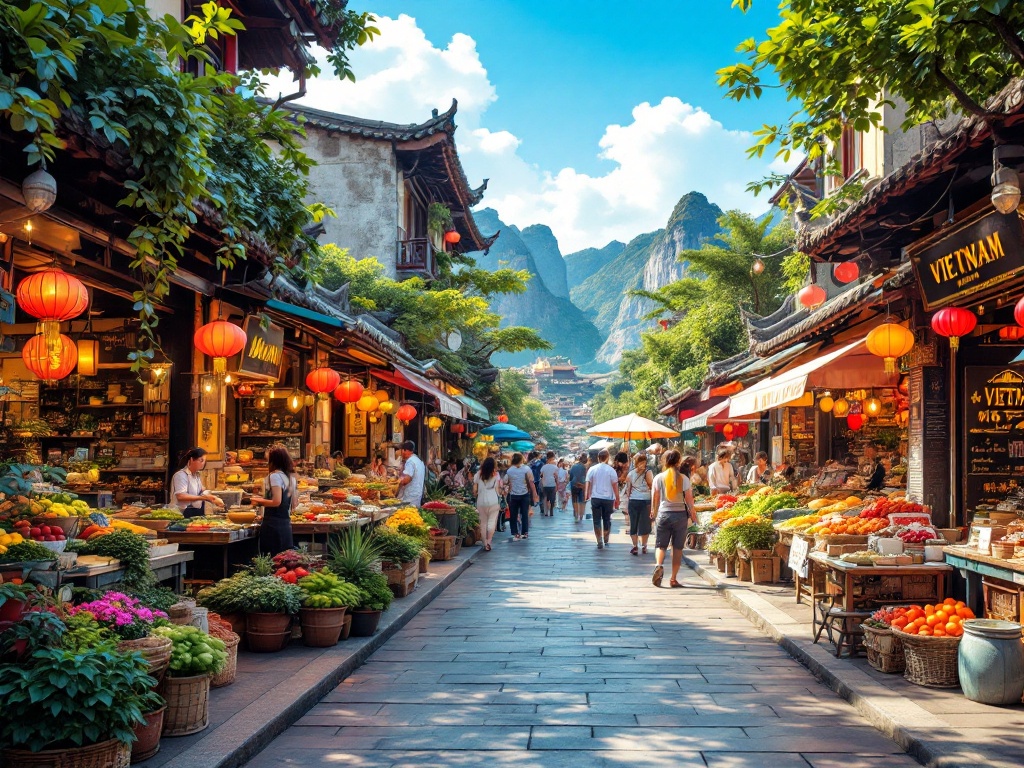
- Vietnam offers a 30-day single-entry e-visa to citizens of 80 countries. Citizens of several other countries enjoy visa-free travel for varying lengths of stay.
- Vietnam is budget-friendly. A mid-range trip costs $30-$50 per day, while luxury travelers can expect to spend $100-$200 a day.
- The country offers diverse landscapes, from bustling cities like Hanoi and Ho Chi Minh City to the natural beauty of Ha Long Bay and the rice terraces of Sapa.
- Vietnamese cuisine is renowned for its fresh ingredients, aromatic herbs, and balanced flavors. Must-try dishes include pho, banh mi, and goi cuon (fresh spring rolls).
- Travelers should get travel insurance, consult their doctor about needed vaccines, and be mindful of local customs. Dress modestly when visiting temples and pagodas.
Understanding Vietnam: A Southeast Asian Gem
Vietnam, a captivating Southeast Asian nation, seamlessly blends ancient traditions with modern life. This rich history shapes its vibrant culture, evident in both bustling cities and tranquil villages. From Hanoi’s energetic streets to the serene waters of Ha Long Bay, the country offers incredibly diverse landscapes. Vietnamese cuisine is a culinary adventure, bursting with fresh ingredients and aromatic flavors. Exploring Vietnam’s heritage enriches any journey, fostering meaningful connections with locals and their customs. Discover traditional crafts or savor regional delicacies. Beyond its cultural richness, Vietnam’s natural beauty is breathtaking. The true essence of Vietnam resides in its warm and resilient people.
Vietnam’s Rich History and Diverse Culture
Vietnam’s captivating history stretches back millennia, from its indigenous origins through periods of Chinese influence and French colonialism, shaping the nation we see today. Family and community are cornerstones of Vietnamese culture, where respect for elders is paramount. Traditional festivals, such as the vibrant Lunar New Year (Tet), offer a glimpse into Vietnamese life with their colorful displays, traditional music, and elaborate costumes. Even daily customs reflect cultural values. Removing shoes before entering a home demonstrates respect. Offering gifts with both hands signifies politeness. Visiting temples and pagodas provides a spiritual experience, but remember to dress respectfully by covering your shoulders and knees.
Stunning Landscapes and Must-See Places
Vietnam offers a captivating blend of natural beauty and cultural richness, from the breathtaking limestone karsts of Ha Long Bay to the bustling streets of Ho Chi Minh City. Explore the ancient architecture of Hoi An, a remarkably preserved trading port. Discover the heart of Vietnam in Hanoi, its capital, where history comes alive. Trek through the verdant rice terraces of Sapa for stunning views. Experience the serenity of the Mekong Delta and gain an intimate look at Vietnamese traditions. Delve into the Cu Chi Tunnels, an underground network that played a vital role in the war and stands as a symbol of the nation’s resilience. Vietnam has an experience for every traveler.
Planning Your Trip to Vietnam
Planning a trip to Vietnam? Follow these steps for a smooth and unforgettable experience.
Check visa requirements. These depend on your nationality, so be sure to research the specific regulations for your country.
Consider the ideal time to visit. Factor in both the weather and your planned activities to determine the best time for your trip.
Establish a budget. Include expenses such as flights, accommodation, food, transportation, and activities.
Decide where you want to explore. Focus on specific regions or cities within Vietnam’s diverse landscape.
Research transportation options. Consider domestic flights, trains, buses, and motorbike rentals.
Explore accommodation options. Choose from budget-friendly hostels to luxurious hotels, depending on your preferences and budget.
When to Visit: Weather and Festivals
Vietnam boasts diverse weather patterns due to its varied geography. Northern Vietnam has cool, drizzly winters from November to April, with temperatures averaging 17-22°C. Summers (May to October) are hot and humid, reaching 30-35°C with heavy downpours, especially in July and August. Central Vietnam is hot and dry from January to August (30-35°C) and rainy from September to December. Southern Vietnam has two seasons: dry (November to April) and wet (May to October). Temperatures remain consistent at 25-35°C with high humidity. Many Vietnamese festivals, including Tet (Lunar New Year), are tied to the lunar calendar. Tet usually falls in late January or early February. Other notable celebrations include the biennial Hue Festival (April or May) and the monthly Hoi An Lantern Festival (during each full moon). Numerous local festivals celebrate harvests and religious occasions.
Visa and e-Visa Information
Vietnam offers a user-friendly 30-day, single-entry e-visa to citizens of 80 countries. Remember to print a copy of your e-visa for immigration officials. Several nationalities enjoy visa-free travel to Vietnam.
Visa-free stays for 14-30 days
- Thailand,
- Malaysia,
- Singapore,
- Indonesia,
- Cambodia,
- Laos,
- the Philippines,
- Brunei.
15-day visa exemption
- Chile,
- Belarus,
- Denmark,
- Finland,
- France,
- Germany,
- Italy,
- Japan,
- Norway,
- Russia,
- South Korea,
- Spain,
- Sweden,
- the UK.
If your country is not eligible for an e-visa or a visa exemption, you will need to apply for a visa through a Vietnamese embassy or consulate. This typically requires a completed application form, passport photos, and your passport. Processing times and fees vary.
Budgeting and Cost Considerations
Vietnam is a fantastic destination for budget-conscious travelers. Diverse accommodation options, ranging from hostels to luxury hotels, cater to every preference. A culinary highlight is the delicious and affordable street food. Transportation is also easy on the wallet, especially buses and trains. Activities like hiking and temple visits are often free or very inexpensive. A mid-range daily budget of $30-$50 per person typically suffices, while luxury travelers can expect to spend $100-$200 per day. Vietnam offers incredible value for your money.
Budget-Friendly Accommodation
From hostels to budget hotels, Vietnam offers a wide range of affordable accommodation options. This allows travelers to find something that suits their needs and budget, without sacrificing comfort.
Delicious and Affordable Cuisine
Vietnamese street food is a culinary adventure. A variety of flavorful dishes can be enjoyed for just a few dollars, making it a budget-friendly way to experience local culture.
Easy and Inexpensive Transportation
Buses and trains provide convenient and affordable transportation throughout Vietnam. This makes it easy to explore different regions and cities without breaking the bank.
Free and Low-Cost Activities
Vietnam offers a wealth of free and low-cost activities, such as hiking, visiting temples, and exploring local markets. This allows travelers to experience the country’s rich culture and natural beauty without overspending.
Recommended Itineraries for First-Time Travelers
Planning your dream Vietnam trip? Here are some itineraries to inspire you.
One Week in Vietnam
Hanoi (2 days): immerse yourself in the city’s vibrant culture, bustling markets, and historic landmarks.
Ha Long Bay (2 days): cruise through the breathtaking bay, kayaking amidst stunning limestone karsts and hidden caves.
Hoi An (3 days): unwind in the ancient town, explore its charming streets, tailor-made clothes, and relax on the beach.
Two Weeks in Vietnam
Hanoi (2 days): experience the capital’s rich culture and history.
Ha Long Bay (2 days): explore the magnificent bay’s stunning scenery.
Hue (2 days): delve into the imperial city’s historical significance.
Hoi An (3 days): soak up the ancient town’s charm and tailor your own souvenirs.
Ho Chi Minh City (3 days): discover the bustling metropolis and its vibrant energy.
Three Weeks in Vietnam
Hanoi (3 days): explore the capital’s cultural treasures and hidden gems.
Ha Long Bay (2 days): cruise through the iconic bay, kayaking and swimming in its turquoise waters.
Ninh Binh (2 days): discover the stunning landscapes of Ninh Binh, known as “Ha Long Bay on land”.
Hue (2 days): immerse yourself in the imperial city’s rich history and architecture.
Hoi An (3 days): wander through the ancient town’s charming streets and get clothes tailored.
Nha Trang (2 days): relax on the beautiful beaches and enjoy the coastal city’s vibrant atmosphere.
Da Lat (2 days): explore the mountain scenery, waterfalls, and French colonial architecture.
Ho Chi Minh City (3 days): experience the dynamic city’s energy, markets, and historical landmarks.
Transportation and Getting Around
Vietnam offers a variety of public transportation options, including trains, buses, and boats. City residents frequently use taxis or ride-sharing services like Grab. For travelers seeking adventure and scenic journeys, motorbikes provide unmatched freedom and a distinctly Vietnamese experience.
Public Transport: Trains, Buses, and Boats
Vietnam offers diverse public transportation options. For long-distance journeys, trains provide scenic routes through the countryside. Buses are a budget-friendly choice for travel between cities. Boats are commonly used for shorter trips, especially along the coast and in the Mekong Delta.
Getting Around Cities
In urban areas, taxis and ride-sharing apps are readily accessible. Downloading a local transportation app can greatly assist with city navigation. When using taxis, always negotiate the fare in advance and confirm the meter is running to avoid overcharges.
Other Options
Xe ôm (motorcycle taxis) offer a quicker, though less safe, way to navigate congested areas. Cyclos (rickshaws) provide a charming, leisurely mode of transport for shorter distances, particularly within city centers.
Using Modern Taxi Services and Ride-Sharing
Ride-hailing services like Grab provide a convenient alternative to traditional taxis, which are also readily available, especially in Vietnam’s urban centers. This makes navigating cities easier.
Motorbiking Across Vietnam
Experience the thrill of motorbike adventures in Vietnam. This mode of transport offers unparalleled freedom and flexibility, allowing you to explore at your own pace, which is ideal for independent travelers. Renting a motorbike is easy, with rentals readily available across the country. However, ensure you are familiar with local traffic laws and possess the necessary licenses, including a potential international driving permit.
Accommodation Options in Vietnam
Vietnam offers incredible accommodation options, from budget-friendly hostels to luxurious resorts. Travelers often choose locations convenient to attractions or transportation. Online agencies simplify comparing prices and amenities, while reviews provide valuable insights.
Budget-friendly
For budget-conscious travelers, hostels with dorm rooms and shared facilities are a great choice.
Mid-range to Luxury
Hotels cater to a range of budgets with private rooms and enhanced amenities. For a truly immersive experience, unique stays like homestays, eco-lodges, and boutique hotels offer a taste of local culture.
Finding the Best Places to Stay
Vietnam offers incredible accommodations for every budget. Whether you’re looking for luxury, romance, family fun, budget-friendly options, or unique cultural experiences, Vietnam has something for everyone.
Luxury and Romance
Luxury travelers can indulge in stunning hotels and resorts. Those seeking romance will find idyllic beach getaways with secluded resorts, private beaches, and couples’ spa treatments.
Family Fun and Budget-Friendly Options
Families can enjoy resorts designed just for them, complete with kids’ clubs and multiple pools. Budget-conscious travelers will appreciate the abundance of affordable hostels and guesthouses in cities and towns.
Unique Cultural Experiences
For a truly unique experience, homestays and eco-lodges provide immersive cultural opportunities.
Hostels, Hotels, and Unique Stays
Vietnam offers incredible accommodations for every traveler. Budget-conscious explorers will find hostels ideal, while those seeking comfort can relax in a range of hotels. For a truly unique experience, consider a homestay for cultural immersion or a boutique hotel for personalized service and chic design. Eco-lodges provide a chance to connect with nature while supporting sustainable tourism.
Budget-friendly options
- hostels, ideal for budget travelers,
- homestays, offering cultural immersion.
Comfort and unique experiences
- hotels, providing a range of comfort levels,
- boutique hotels, offering personalized service and chic design,
- eco-lodges, allowing connection with nature and supporting sustainable tourism.
Exploring Vietnam’s Top Destinations
Vietnam, a captivating country, offers diverse experiences for every traveler. Explore Hanoi, the historic capital, and visit the Ho Chi Minh Mausoleum and the Temple of Literature. For those seeking natural beauty, Ha Long Bay, a UNESCO World Heritage Site, awaits with its thousands of limestone karsts rising from emerald waters. Trek through the stunning rice terraces of Sapa in northern Vietnam, or discover the ancient trading port of Hoi An. Experience the vibrant energy of Ho Chi Minh City and journey through the Mekong Delta for a taste of rural life. Don’t miss the ancient Cham ruins at My Son Sanctuary.
Hanoi: The Vibrant Capital
Hanoi, Vietnam’s capital, is a captivating blend of ancient and modern. Explore the historic Imperial Citadel of Thăng Long and the serene Temple of Literature, remnants of a rich past. Hanoi also thrives with contemporary energy. Bustling markets offer a sensory explosion, while vibrant street food tantalizes taste buds. Don’t miss the traditional water puppet shows for a unique cultural experience.
Ha Long Bay: A UNESCO World Heritage Site
Ha Long Bay, a UNESCO World Heritage Site, is renowned for its breathtaking emerald waters. Towering limestone karsts and isles punctuate the seascape, with over 1,600 of these dramatic formations rising from the bay.
Sapa: Breathtaking Rice Terraces
Sapa’s rice terraces cascade down the Muong Hoa Valley, creating a vibrant tapestry of green and gold. This breathtaking view transforms with the seasons. From the fresh growth of spring, to the golden hues of autumn, and the serene winter months, the ever-changing landscape offers unique vistas throughout the year. However, the terraces’ natural beauty remains a constant wonder.
Other Must-See Locations
Nha Trang’s stunning beaches make it a coastal paradise perfect for diving enthusiasts. History buffs will appreciate Hue, with its impressive imperial citadel and royal tombs. For the adventurous, Phong Nha-Ke Bang National Park offers Son Doong, the world’s largest cave. Seeking a different kind of experience? Hoi An, a charming ancient trading port, captivates visitors with its talented tailors and vibrant lanterns. Finally, immerse yourself in the unique culture of the Mekong Delta, exploring its floating markets and lush rice paddies for an unforgettable journey.
Nha Trang: Stunning beaches and a diver’s paradise.
Hue: Explore the imperial citadel and royal tombs.
Phong Nha-Ke Bang National Park: Discover Son Doong, the world’s largest cave.
Hoi An: A charming ancient trading port with talented tailors and vibrant lanterns.
Mekong Delta: Immerse yourself in the unique culture, floating markets, and lush rice paddies.
Cultural and Authentic Experiences
Observe these customs during your travels in Vietnam:
- Show respect, politeness, and modesty at all times.
- Dress modestly when visiting temples and pagodas.
- Remove your shoes before entering homes and some businesses.
- Greet people with a slight bow and a warm smile.
- Bargain respectfully in markets.
- Avoid public displays of affection.
- Keep your voice down and refrain from pointing.
Additional tips for respectful travel:
- While tipping isn’t mandatory, it’s appreciated for good service.
- Ask permission before taking someone’s photograph.
- Learning basic Vietnamese phrases enhances interactions.
- Accept gifts with both hands on special occasions.
Experience Vietnamese culture by participating in these important celebrations:
Tet (Lunar New Year): Vietnam’s most important celebration.
Hung Kings’ Temple Festival: Honors the nation’s founders.
Buddha’s Birthday: A significant religious holiday.
Mid-Autumn Festival: Celebrated with mooncakes and lanterns.
Reunification Day: Commemorates the end of the Vietnam War.
National Day: Celebrates Vietnam’s independence.
Many festivals showcase traditional music, dance, and cuisine. Check local listings for specific dates and locations for a truly enriching cultural experience.
Local Etiquette and Cultural Tips
When visiting, dress modestly, especially in religious sites. A slight bow is a polite greeting; handshakes are uncommon. Offer and receive items with both hands as a sign of respect. Ask permission before taking a photo. At meals, wait for the host to begin eating. Avoid sticking chopsticks upright in a bowl of rice, as this is considered disrespectful. Remove your shoes before entering homes and some businesses.
Dress modestly, especially when visiting religious sites.
A slight bow is a polite greeting.
Offer and receive items with both hands to show respect.
Ask permission before taking a photo.
At meals, wait for the host to begin eating.
Avoid sticking chopsticks upright in a bowl of rice.
Remove your shoes before entering homes and some businesses.
Participating in Festivals and Public Holidays
Vietnamese festivals and public holidays offer a vibrant glimpse into the nation’s rich culture. Tet, the Lunar New Year, centers around family and time-honored traditions. Homes are adorned with festive decorations, special dishes are prepared, and families gather in celebration. The Hung Kings’ Festival is a patriotic occasion honoring Vietnam’s founders. Reunification Day, observed on April 30th, commemorates the end of the Vietnam War and evokes both remembrance and national pride. These occasions provide a unique opportunity to witness vibrant performances and savor delicious local cuisine, truly showcasing Vietnam’s heritage.
Vietnamese Cuisine: A Culinary Journey
Vietnamese cuisine is a vibrant tapestry of fresh ingredients, aromatic herbs, and balanced flavors. Street food is an integral part of this culinary experience. Some iconic dishes include pho, a savory noodle soup, and banh mi, a flavorful sandwich. For a lighter meal, try fresh spring rolls often filled with shrimp or pork. Regional specialties, such as the seafood dishes of Ha Long Bay, further enhance Vietnam’s food scene.
Experience Vietnamese Cuisine
- Take a cooking class for hands-on experience with Vietnamese techniques and ingredients.
- Explore local markets to see vendors displaying vibrant produce, herbs, and spices.
- Dine at family-owned restaurants showcasing authentic, time-honored recipes.
Don’t Miss
Vietnam’s distinctive coffee culture, featuring strong, flavorful coffee often sweetened with condensed milk, is a true culinary delight.
Must-Try Dishes and Local Delicacies
Vietnam’s food scene is incredible. From the flavorful pho, a comforting noodle soup, to the unique banh mi sandwich, your taste buds are in for a treat. For a lighter option, try goi cuon, refreshing fresh spring rolls. Vietnamese cuisine offers so much more! Explore regional specialties like Cao Lau in Hoi An and Bun Cha in Hanoi to experience the country’s culinary diversity. Coastal areas boast an impressive variety of fresh seafood. Don’t miss the authentic culinary adventure of street food. Explore local markets and even consider a cooking class.
Experiencing Vietnam’s Coffee Culture
Vietnamese coffee culture offers a unique and immersive experience. A small metal filter, called a phin, produces a rich, strong brew. This distinctive coffee serves as the foundation for beloved Vietnamese beverages. These include cà phê sữa đá (iced coffee with condensed milk) and the unique egg coffee. Coffee stalls and cafes are a common sight throughout Vietnam’s streets. They offer vibrant hubs to enjoy these local specialties and observe traditional brewing methods up close.
Health, Safety, and Practical Advice
Health and Safety
Invest in travel insurance that covers medical emergencies, trip cancellations, and lost belongings. Consult your doctor about necessary vaccinations and malaria prevention. Pack essential items, including insect repellent, sunscreen, and a first-aid kit.
Regarding food and water safety, opt for bottled water. Exercise caution with street food, especially dishes with raw ingredients. Be vigilant against scams and theft. Secure your valuables and avoid displaying expensive jewelry or electronics.
Medical Facilities
Major cities offer international hospitals and clinics with English-speaking staff. Local pharmacies provide over-the-counter remedies for minor ailments. Medical facilities in remote areas may be limited, so ensure your travel insurance covers medical evacuation. Always carry copies of your passport, visa, and insurance information.
Local Customs and Communication
Navigating Vietnam’s traffic can be tricky. Exercise extra caution when crossing the street and rely on reputable taxis or ride-sharing services. Learning basic Vietnamese phrases enhances communication and demonstrates cultural respect. Researching local customs is also advisable.
Currency and Internet Access
Vietnam’s official currency is the Vietnamese Dong (VND). ATMs are readily available in cities and towns, and credit cards are accepted in larger establishments. Cash is preferred for smaller businesses and street vendors, though US dollars are sometimes accepted. It’s generally advisable to use the local currency.
Internet access is excellent throughout Vietnam, with Wi-Fi widely available in hotels, cafes, and restaurants. Affordable local SIM cards offer excellent mobile data coverage, making them a worthwhile purchase upon arrival for easy communication and navigation.
Health and Safety Tips for Travelers
Planning a trip to Vietnam? Here’s a helpful guide to ensure a safe and healthy journey:
Schedule a pre-trip consultation with your doctor to discuss recommended vaccinations and necessary medications.
Pack essential items for health and safety, including insect repellent, sunscreen, and a first-aid kit.
Drink bottled water to avoid waterborne illnesses.
When indulging in street food, choose reputable vendors to minimize health risks.
Be aware of your surroundings, particularly at night, and avoid walking alone in poorly lit areas.
Safeguard your belongings in crowded tourist areas to prevent petty theft.
Learning basic Vietnamese phrases can be invaluable in emergencies.
Obtain comprehensive travel insurance that covers medical expenses and other unforeseen events.
Research local customs and traditions to demonstrate respect and enhance your travel experience.
Share your itinerary with a contact back home and check in regularly.
In case of an emergency, contact your embassy or consulate for assistance.
Accessing Medical Facilities in Vietnam
Vietnam’s major cities offer excellent medical care for visitors. Numerous international hospitals and clinics, staffed by English speakers, are particularly concentrated in urban areas.
Pharmacies are widespread and easily accessible, dispensing both prescription and over-the-counter medications. While medical resources are readily available, medical evacuation might be necessary for severe conditions. Travel insurance is strongly recommended to cover potential costs and ensure peace of mind.
Currency and Payment Methods
The official currency of Vietnam is the đồng (VND). Major credit cards, including Visa, Mastercard, and American Express, are widely accepted at larger establishments. However, it’s advisable to carry cash for smaller businesses, which may prefer it. Exchanging currency is straightforward, with banks, hotels, and exchange counters readily available. ATMs are also widespread throughout the country.
Staying Connected: Internet and SIM Cards
Staying connected in Vietnam is easy and affordable thanks to inexpensive data plans available with local SIM cards. Major providers include Viettel, Mobifone, and Vinaphone. Free Wi-Fi is also widely available in most cafes, restaurants, and hotels, making it incredibly convenient to stay online.

